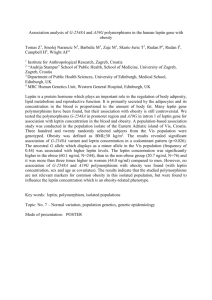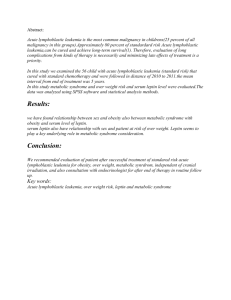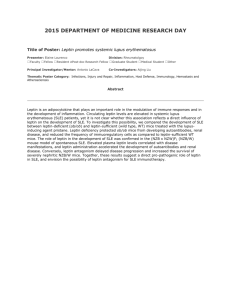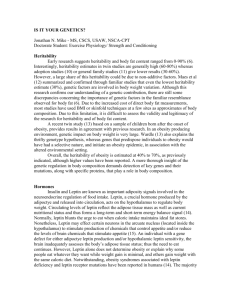Zhong N, Wu XP, Xu ZR, Wang AH, Luo XH, Cao XZ, et al
advertisement
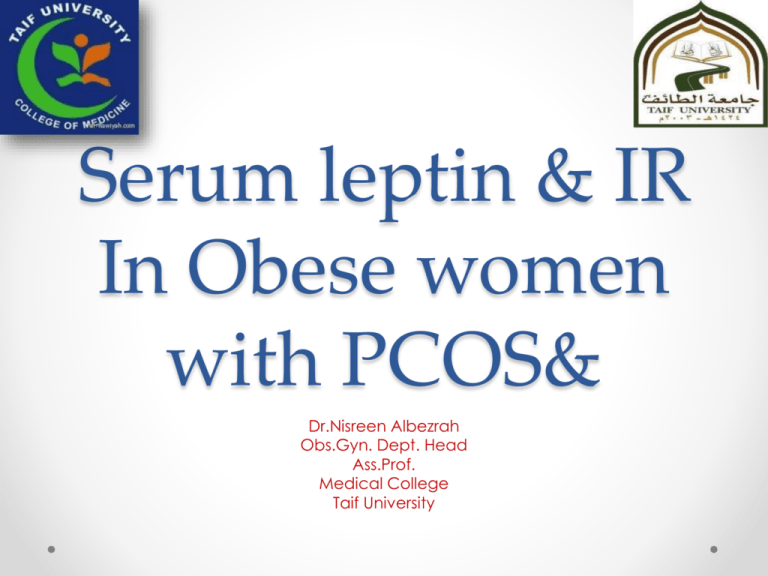
Serum leptin & IR In Obese women with PCOS& Dr.Nisreen Albezrah Obs.Gyn. Dept. Head Ass.Prof. Medical College Taif University introduction • Polycystic ovary syndrome(PCOS) is a heterogeneous endocrine disorder affects one in 15 women worldwide. • characterized by hirsutism, acne, anovulation, hyperandrogenemia, polycystic ovaries, and infertility. • Obesity in particular, central obesity is present in 10– 65% of women with PCOS • Body fat distribution is also important as central/abdominal obesity is associated with IR and has a greater impact on fertility. • The presence of obesity can also magnify IR. • In most cases, PCOS also involves metabolic alterations such as insulin resistance (IR), hyperinsulinemia, dyslipidemia, and obesity • lead to an increased risk of developing endometrial cancer type 2 DM cardiovascular disease compared with the general population • The adverse effects of obesity on female fertility include impaired ovulation, oocyte maturation irregular menstrual cycle, endometrial development, uterine receptivity elevated miscarriage rate, lower implantation, and lower pregnancy rates • Adipose tissue has been revealed to play important roles in the regulation of many physiological processes by secreting cytokines named adipokines that exert multiple effects at both the local and the systemic level • It has been associated with body mass index (BMI), insulin action, and glucose metabolism.. • Adipokines comprise : Non adipose-specific cytokines such as retinol binding protein-4 (RBP4), lipocalin-2 (LCN2), interleukin 6 (IL6), IL1β, and tumor necrosis factor α (TNFα) Adipose-specific cytokines or cytokines, such as, adiponectin (APN), resistin, and leptin. • Leptin is a 16 kDa protein which is produced by adipocytes, that plays a key role in regulating energy intake and energy expenditure, including appetite and metabolism -Chen X1, Jia X, Qiao J, Guan Y, Kang J. Adipokines in reproductive function: a link between obesity and polycystic ovary syndrome. J Mol Endocrinol. 2013; 50:R21-37 -Zhang Y, Proenca R, Maffei M, Barone M, Leopold L, Friedman JM. Positional cloning of the mouse obese gene and its human homologue. Nature 1994; 372:425– 32 • leptin is widely present in reproductive tissues, its relationship to reproductive hormones is still poorly understood. • The deficiency of leptin or leptin receptors (LEPR) due to loss of function mutations in the corresponding genes has been linked to infertility and delayed puberty development in humans and rodents. • leptin and its receptor have been implicated in maintaining other normal female reproductive functions including : • lactation, • folliculogenesis, • ovarian steroidogenesis, • development of dominant follicles and oocytes, • maturation endometrial development, • menstrual cycle regulation and endometrial receptivity . • The heterogeneity of clinical manifestations of PCOS patients makes this syndrome even challenging in the field of endocrinology, metabolism, and reproduction. • Our current understanding of the role for leptin in PCOS is far from complete. • This study aimed to investigate changes in serum leptin concentrations among obese women with PCOS and healthy obese women METHEDOLOGY • King Abd El-Aziz Hospital (Department of Obstetric &Gynecology) • 56 subjects who divided into two main groups 40 women with PCOS their mean age was 34.3 ± 2.08 years 16 women obese control • All patients are having normal other hormones level & non on using any horm. treatments or drugs • None of them had detectable pituitary or hypothalamic dysfunction. • None had received any drugs known to interfere with hormonal concentrations for at least 3 months before the study. • Blood samples were used for estimation of serum fasting blood glucose, Insulin& FSH, LH progesterone prolactin, and testosterone levels leptin assay Insulin resistance was estimated by means of homeostasis model assessment for insulin resistance (HOMA-IR) index which is calculated by the formula: fasting insulin concentration (μIU/mL) × fasting blood glucose (mmol/L)/22.5 • Statistical analysis: -performed using IBM SPSS software package version 20.0 -continuous variables were presented as means ± standard deviation (SD -Pearson correlation coefficient was used to determine the relationship between continuous variables -independent sample t-test was used. - P value less than 0.05 was considered as a statistically significant Group I (n=40) Group II (n=16) t P value Age (years) 34.3 ± 2.08 28.1 ± 4.61 2.04 0.138 BMI (kg/m2) 34.84 ± 4.77 33.59 ± 1.23 2.207 0.078 Glucose (μIU/mL) 6.04± 1.61 4.75± 0.26 2.161 0.067 Insulin (μIU/mL) 11.02± 4.79 9.30 ± 5.71 1.018 0.343 HOMA-IR 2.96± 1.43 2.12±1.44 1.671 0.139 FSH (mIU/mL) 4.80 ± 2.58 6.8 ± 1.73 2.320 0.049* LH (mIU/mL) 7.71± 6.91 5.14 ± 1.65 1.177 0.027* Testosterone (ng/mL) 0.91± 0.49 0.49 ± 0.3 2.427 0.046* Progesterone (nmol/L) 0.90± 2.01 4.3±2.1 2.161 0.045* Prolactin (ng/mL) 15.18± 10.68 13.26 ± 1.35 0.571 0.582 Leptin (ng/mL) 23.78± 5.99 16.86 ± 0.90 3.647 0.005* Variable Table 1 Mean Age, Anthropometric Measurement, Metabolic and Hormonal Zhong N, Wu XP, Xu ZR, Wang AH, Luo XH, Cao XZ, et al. Relationship of serum leptin with age, body weight, body mass index, and bone mineral density in healthy mainland Chinese women. Clin Chim Acta 2005; 351: 161-8 Leptin Variable r p Age 0.633 0.367 BMI 0.809 0.049* Prolactin -0.094 0.796 Progesterone -0.425 0.221 LH -0.088 0.810 FSH 0.225 0.560 Testosterone -0.119 0.780 Glucose 0.052 0.903 Insulin 0.279 0.503 HOMA 0.315 0.447 Table (II): Correlation between leptin and different parameters Zhong N, Wu XP, Xu ZR, Wang AH, Luo XH, Cao XZ, et al. Relationship of serum leptin with age, body weight, body mass index, and bone mineral density in healthy mainland Chinese women. Clin Chim Acta 2005; 351: 161-8 Noninsulin resistant subgroup (n = 15) mean ± SD Insulin resistant subgroup (n =25) mean ± SD t P value 30.03±4.58 32.4±3.39 0.614 0.413 BMI (kg/m2) Leptin (ng/mL) 0.044* 16.22±2.59 25.52±5.56 3.35 Table III BMI and Serum Leptin Level in Noninsulin Resistant and Insulin Resistant Obese Women with PCOS -Conway GS, Jacobs HS: Leptin: A hormone of reproduction. Hum Reprod 1997; 12:633–5 -Poretsky L, Kahin MF. The gonadotropic function of insulin. Endocrinol Rev 1987; 8:134–41 • Leptin may have a role in the ovarian dysfunction in obese patients with PCOS. • The body mass index and insulin resistance are the two main factors Governing serum leptin levels. • Emphasis on the importance of early detection and education for patients with polycystic ovary syndrome. • The importance of developing strategy that consider following up patients with polycystic ovary syndrome for monitoring their hormonal levels, diet as well as their weight. • The need for further studies in larger subjects and in different areas in the kingdom of Saudi Arabia with REFERENCES • • • • • • • • • • • Syed M, Cozart M, Haney AC. Ghrelin restoration of function in vitro in somatotropes from male mice lacking the Janus kinase (JAK)-binding site of the leptin receptor. Endocrinology. 2013; 154:1565–1576. Navarro VM, Kaiser UB. Metabolic influences on neuroendocrine regulation of reproduction. Curr Opin Endocrinol Diabetes Obes. 2013; 20:335-41 Lim SS, Davies MJ, Norman RJ, Moran LJ. Overweight, obesity and central obesity in women with polycystic ovary syndrome: a systematic review and meta-analysis. Human Reproduction Update 2012; 18: 618–37 Bohler H, Mokshagundam S, Winters SJ. Adipose tissue and reproduction in women. Fertility and Sterility 2010; 94: 795–825 Donato JJ, Cravo RM, Frazao R, Gautron L, Scott MM, Lachey J, et al. Leptin's effect on puberty in mice is relayed by the ventral premammillary nucleus and does not require signaling in Kiss1 neurons. Journal of Clinical Investigation 2011; 121:355–68 Carmina E, Ferin M, Gonzalez F, Lobo RA. Evidence that insulin and androgens may participate in the regulation of serum leptin levels in women. Fertility and Sterility 1999; 72:926–31 Remsberg KE, Talbott EO, Zborowski JV, Evans RW, McHugh-Pemu K. Evidence for competing effects of body mass, hyper-insulinemia, insulin resistance, and androgens on leptin levels among lean, overweight, and obese women with polycystic ovary syndrome. Fertility and Sterility 20027; 8: 479–86 Mantzoros CS, Dunaif A , Flier JS. Leptin concentrations in the polycystic ovary syndrome. Journal of Clinical Endocrinology and Metabolism 1997; 82:1687–91 Saleh HA, El-Nwaem MA, El-Bordiny MM, Maqlad HM, El-Mohandes AA, Eldaqaq EM. Serum leptin elevation in obese women with PCOs: a continuing controversy. Journal of Assisted Reproduction and Genetics 2004 ; 21:361-6 Krotkiewski M, Landin K, Dahlgren E, Janson PO, Holm G. Effect of two modes of anti-androgen treatment on insulin sensitivity and serum leptin in women with PCOS. Gynecologic and Obstetric Investigation 2003; 55: 88–95 Brzechaffa PR, Jakimiuk AJ, Agarwal SK, Weitsman SR, Buyalos RP, Magoffin DA. Serum immunoreactive leptin concentrations in women with polycystic ovary syndrome. J Clin Endocrinol Metab 1996; 81:4166–71 THANK YOU
